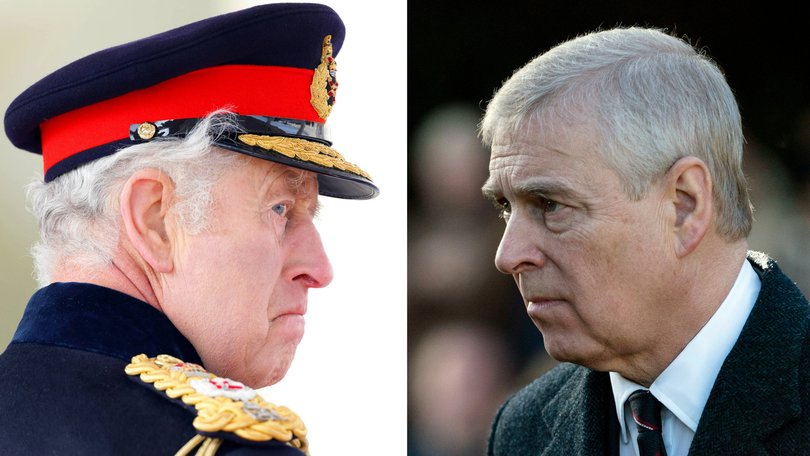Andrew Mountbatten Windsor: Five times the British royal family has been ruthless with its own

King Charles III acted briskly - as briskly as a Windsor ever does - and rather ruthlessly in dealing with his embattled brother. The king declared he was stripping Andrew of his “prince” title and that he would soon be leaving his Windsor lodgings.
The fine print - that Andrew supposedly had an ironclad lease on Royal Lodge or that as the son of Queen Elizabeth II he was born a prince - turned out to be pesky details.
After days of bruising headlines, the king’s brother would henceforth be known as plain old Andrew Mountbatten Windsor and would soon be vacating the Royal Lodge mansion.
Sign up to The Nightly's newsletters.
Get the first look at the digital newspaper, curated daily stories and breaking headlines delivered to your inbox.
By continuing you agree to our Terms and Privacy Policy.One could almost hear the moving vans idling in the press release.
“Charles is dutifully acting to preserve the monarchy and maintain its reputation by sacrificing his brother,” said royal historian Ed Owens, who added that the monarchy could have “saved itself a lot of trouble” had these actions been taken after Andrew’s ill-fated 2019 BBC interview.
It may not have been quick, but it was classically royal: Charles put the crown first. The British monarchy has endured for more than 1000 years precisely because it has shown cold, even surgical, pragmatism. Kings and queens down the ages have demonstrated that when duty collides with blood, the institution wins - even if it means sacrificing one of their own.
Here are five moments when British royals have shown royal survival instincts triumphing over family ties.
Harry and Meghan, 2020
When Prince Harry and Meghan, complaining about their harassment by the tabloid press, proposed a new working arrangement, Queen Elizabeth II barely gave it a second glance. She made it clear that they could not have a “half-in, half-out” role and live abroad part time while continuing official duties and keeping their security detail.
In his memoir “Spare,” Harry recounts the “Sandringham Summit” in January 2020 in which his grandmother, father, brother and senior aides determined the terms of their departure.
Harry wrote that five options were discussed, ranging from keeping the status quo, to complete separation. After an hour of discussion, he said, he was handed a statement Buckingham Palace would release announcing option 5. Harry described feeling blindsided. “The fix was in, this whole time? The summit was just for show?” he recalled asking. There was, he wrote, “no answer.”
Owens, the historian, noted that in this case, Elizabeth herself may have been more open to compromise, but the courtiers were not. “The institution is run by cold-blooded individuals,” he said, “who don’t get drawn into emotional wars.”

The princess and the captain, 1955
The romance between Princess Margaret and Group Captain Peter Townsend captivated 1950s Britain. Townsend, a dashing war hero who had worked for the royal household, fell in love with Queen Elizabeth’s glamorous, high-spirited younger sister.
But Townsend was divorced, a serious problem under the rules of the Church of England, of which Elizabeth was the head. The queen asked her sister to wait a year; Townsend was dispatched to Brussels.
Owens, the historian, said while it’s not known exactly what passed between the sisters, it’s believed that the queen made it clear that if Margaret married Townsend, she would have to give up her royal duties - and the privileges that come with them.
For 25-year-old Margaret, the privileges won out. “I have been aware that, subject to my renouncing my rights of succession, it might have been possible for me to contract a civil marriage. But, mindful of the Church’s teaching that Christian marriage is indissoluble, and conscious of my duty to the Commonwealth, I have resolved to put these considerations before any others,” she said in a statement.
The crown won, love lost.
Abdication, 1936
That hadn’t been the case a generation earlier. The abdication of King Edward VIII remains the ultimate royal sacrifice.
Less than a year into his reign, Edward VIII chose love over the monarchy, or perhaps the monarchy chose the throne over him. His wish to marry Wallis Simpson, an American divorcée, was blocked by the government and the Church of England, whose teachings at the time opposed remarriage after divorce.
“I have found it impossible,” he told the nation in a speech, “to carry on the heavy burden of responsibility and to discharge the duties of king, as I would wish to do, without the help and support of the woman I love.”
Edward was hugely popular with the public but distrusted by the establishment. Owens noted that courtiers around his successor, George VI, quickly moved to contain the risk.
“There were some very canny forces around him,” he said, “who saw that Edward was toxic - that he had the potential to undermine George’s reign. To manage it effectively, they kept Edward and Wallis as far from the U.K. as possible.”
Not a bad idea, as it turned out since Edward VIII’s sympathies ran rather famously too close to the Third Reich for comfort and World War II was around the corner.
Wartime monarch, 1917
It wasn’t the first time that the royal family’s relations with Germany came under scrutiny. King George V reigned during World War I, the earlier continental tussle with Berlin, and his role as a wartime monarch demanded patriotism and pragmatism. In 1917, with anti-German sentiment running high, he changed the royal family’s name from Saxe-Coburg and Gotha to the resolutely British-sounding Windsor, and he stripped his German relatives of their British titles.
He also refused asylum to his cousin Tsar Nicholas II of Russia, a wartime ally, fearing that sheltering a deposed autocrat could inflame social unrest at home.
Princes in the tower, 1483
Medieval monarchs played for similar stakes, but there were no courtiers drafting statements or unnamed “royal sources” briefing the press. There were just kings, nephews and a convenient fortress down the road. One of the most notorious cases of royal bloodletting is the story of the princes in the tower.
When Edward IV died, his 12-year-old son took the throne and became Edward V, while his uncle, Richard, Duke of Gloucester, became Lord Protector, effectively a caretaker king. Within weeks, however, Richard had declared his nephews illegitimate and confined them to the Tower of London. He crowned himself Richard III and the princes disappeared soon after. It was never proved that Richard killed the children.
Why would he have had the boys killed? Maybe he thought a 12-year-old couldn’t hold the country together in the midst of a civil war - the War of the Roses - or maybe he just wanted power. Two years later, however, he himself was deposed by Henry Tudor at the Battle of Bosworth and a ruthless new family took the throne.
© 2025 , The Washington Post
